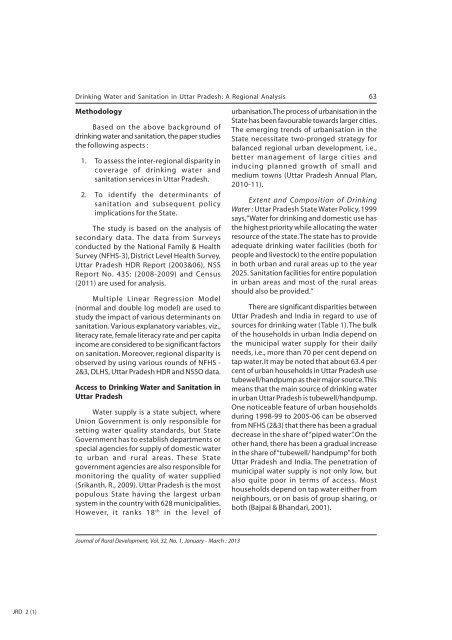January - March 2013 - National Institute of Rural Development
January - March 2013 - National Institute of Rural Development
January - March 2013 - National Institute of Rural Development
- No tags were found...
Create successful ePaper yourself
Turn your PDF publications into a flip-book with our unique Google optimized e-Paper software.
Drinking Water and Sanitation in Uttar Pradesh: A Regional Analysis 63MethodologyBased on the above background <strong>of</strong>drinking water and sanitation, the paper studiesthe following aspects :1. To assess the inter-regional disparity incoverage <strong>of</strong> drinking water andsanitation services in Uttar Pradesh.2. To identify the determinants <strong>of</strong>sanitation and subsequent policyimplications for the State.The study is based on the analysis <strong>of</strong>secondary data. The data from Surveysconducted by the <strong>National</strong> Family & HealthSurvey (NFHS-3), District Level Health Survey,Uttar Pradesh HDR Report (2003&06), NSSReport No. 435: (2008-2009) and Census(2011) are used for analysis.Multiple Linear Regression Model(normal and double log model) are used tostudy the impact <strong>of</strong> various determinants onsanitation. Various explanatory variables, viz.,literacy rate, female literacy rate and per capitaincome are considered to be significant factorson sanitation. Moreover, regional disparity isobserved by using various rounds <strong>of</strong> NFHS -2&3, DLHS, Uttar Pradesh HDR and NSSO data.Access to Drinking Water and Sanitation inUttar PradeshWater supply is a state subject, whereUnion Government is only responsible forsetting water quality standards, but StateGovernment has to establish departments orspecial agencies for supply <strong>of</strong> domestic waterto urban and rural areas. These Stategovernment agencies are also responsible formonitoring the quality <strong>of</strong> water supplied(Srikanth, R., 2009). Uttar Pradesh is the mostpopulous State having the largest urbansystem in the country with 628 municipalities.However, it ranks 18 th in the level <strong>of</strong>urbanisation. The process <strong>of</strong> urbanisation in theState has been favourable towards larger cities.The emerging trends <strong>of</strong> urbanisation in theState necessitate two-pronged strategy forbalanced regional urban development, i.e.,better management <strong>of</strong> large cities andinducing planned growth <strong>of</strong> small andmedium towns (Uttar Pradesh Annual Plan,2010-11).Extent and Composition <strong>of</strong> DrinkingWater : Uttar Pradesh State Water Policy, 1999says, “Water for drinking and domestic use hasthe highest priority while allocating the waterresource <strong>of</strong> the state. The state has to provideadequate drinking water facilities (both forpeople and livestock) to the entire populationin both urban and rural areas up to the year2025. Sanitation facilities for entire populationin urban areas and most <strong>of</strong> the rural areasshould also be provided.”There are significant disparities betweenUttar Pradesh and India in regard to use <strong>of</strong>sources for drinking water (Table 1). The bulk<strong>of</strong> the households in urban India depend onthe municipal water supply for their dailyneeds, i.e., more than 70 per cent depend ontap water. It may be noted that about 63.4 percent <strong>of</strong> urban households in Uttar Pradesh usetubewell/handpump as their major source. Thismeans that the main source <strong>of</strong> drinking waterin urban Uttar Pradesh is tubewell/handpump.One noticeable feature <strong>of</strong> urban householdsduring 1998-99 to 2005-06 can be observedfrom NFHS (2&3) that there has been a gradualdecrease in the share <strong>of</strong> “piped water”. On theother hand, there has been a gradual increasein the share <strong>of</strong> “tubewell/ handpump” for bothUttar Pradesh and India. The penetration <strong>of</strong>municipal water supply is not only low, butalso quite poor in terms <strong>of</strong> access. Mosthouseholds depend on tap water either fromneighbours, or on basis <strong>of</strong> group sharing, orboth (Bajpai & Bhandari, 2001).Journal <strong>of</strong> <strong>Rural</strong> <strong>Development</strong>, Vol. 32, No. 1, <strong>January</strong> - <strong>March</strong> : <strong>2013</strong>JRD 2 (1)
















